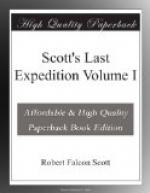This morning we were away over the floe about 9 A.M. I was anxious to see how the motors started up and agreeably surprised to find that neither driver took more than 20 to 30 minutes to get his machine going, in spite of the difficulties of working a blow lamp in a keen cold wind.
Lashly got away very soon, made a short run of about 1/2 mile, and then after a short halt to cool, a long non-stop for quite 3 miles. The Barrier, five geographical miles from Cape Armitage, now looked very close, but Lashly had overdone matters a bit, run out of lubricant and got his engine too hot. The next run yielded a little over a mile, and he was forced to stop within a few hundred yards of the snow slope leading to the Barrier and wait for more lubricant, as well as for the heat balance in his engine to be restored.
This motor was going on second gear, and this gives a nice easy walking speed, 2 1/2 to 3 miles an hour; it would be a splendid rate of progress if it was not necessary to halt for cooling. This is the old motor which was used in Norway; the other machine has modified gears. [30]
Meanwhile Day had had the usual balancing trouble and had dropped to a speck, but towards the end of our second run it was evident he had overcome these and was coming along at a fine speed. One soon saw that the men beside the sledges were running. To make a long story short, he stopped to hand over lubricating oil, started at a gallop again, and dashed up the slope without a hitch on his top speed—the first man to run a motor on the Great Barrier! There was great cheering from all assembled, but the motor party was not wasting time on jubilation. On dashed the motor, and it and the running men beside it soon grew small in the distance. We went back to help Lashly, who had restarted his engine. If not so dashingly, on account of his slower speed, he also now took the slope without hitch and got a last handshake as he clattered forward. His engine was not working so well as the other, but I think mainly owing to the first overheating and a want of adjustment resulting therefrom.
Thus the motors left us, travelling on the best surface they have yet encountered—hard windswept snow without sastrugi—a surface which Meares reports to extend to Corner Camp at least.




